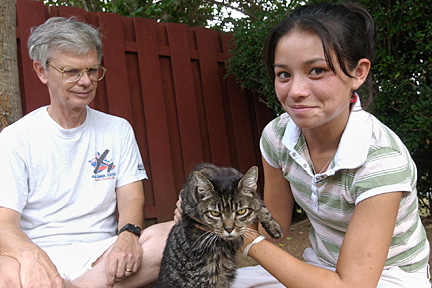
|
Isle teen beats scientists
in cat taste study
When a mainland research institute announced to the world last week how its scientists had discovered that cats are unable to taste sweets, it was old news to Oahu teen Lisa Manuzak.
Five years old, in fact.
That's when Lisa, as a 12-year-old seventh-grader at St. Anthony's School in Kailua, came to a similar conclusion in a district science fair experiment on the finicky eating habits of her family's felines, Pepper and Soy Sauce. Her project earned her third place in the fair.
Fast-forward to last Monday when Lisa, now 17, read an Associated Press article in the Honolulu Star-Bulletin reporting that scientists from the prestigious-sounding Monell Chemical Senses Center in Philadelphia "found a dysfunctional feline gene that probably prevents cats from tasting sweets, a sensation nearly every other mammal on the planet experiences to varying degrees."
"Hey, this is just like my project," Manuzak recalled saying. "Somebody else must have wondered about it, too. It was really cool somebody did something with it."
Lisa's father, Robert, who helped her with the project, said he is proud that his daughter was able to arrive at the same conclusion without the backing of a scientific institute, and five years earlier.
The senior Manuzak said Lisa kept track of the taste preferences of her two cats, who are now 9 and 13, for a month.
She flavored one bowl of water with a little salt, another with a little sugar, a third with a sour flavor and a fourth with bitter flavor. She left a fifth bowl with plain water.
He said the cats would drink "a little" of the salty water and turned up their noses at the sour and bitter water. But they drank from the sugared and plain bowls of water "exactly the same number of times," and she concluded that the cats could not tell the difference.
Lisa said she decided on the project after noticing that most cat foods are composed of meat and other salty ingredients, and if some meat or fries fell on the floor, the cats would eat it. But they ignored foods like candy or ice cream.
While working on the project, Robert said, they conducted thorough Internet research. Also, "We looked at every encyclopedia and (through) books," he said. "None mentioned anything about taste.
"It's too late to wish for a scholarship. If the significance of it (her findings) had been noticed then, she would have won a scholarship because this matters. It was an original work, too, because apparently nobody knew about it before," he said.
Lisa's teacher at St. Anthony's, Marcia McCrea Clinton, said she clearly remembers the cat project as well as the other two Manuzak girls -- "that's a family who loved their cats."
Lisa, who just graduated from Maryknoll High School and plans to attend the University of California in Irvine in the fall, said she "isn't into science that much," but she still remembers the A she received for her cat project.
E-mail to City Desk
[News] [Business] [Features] [Sports] [Editorial] [Do It Electric!]
[Classified Ads] [Search] [Subscribe] [Info] [Letter to Editor]
[Feedback]
